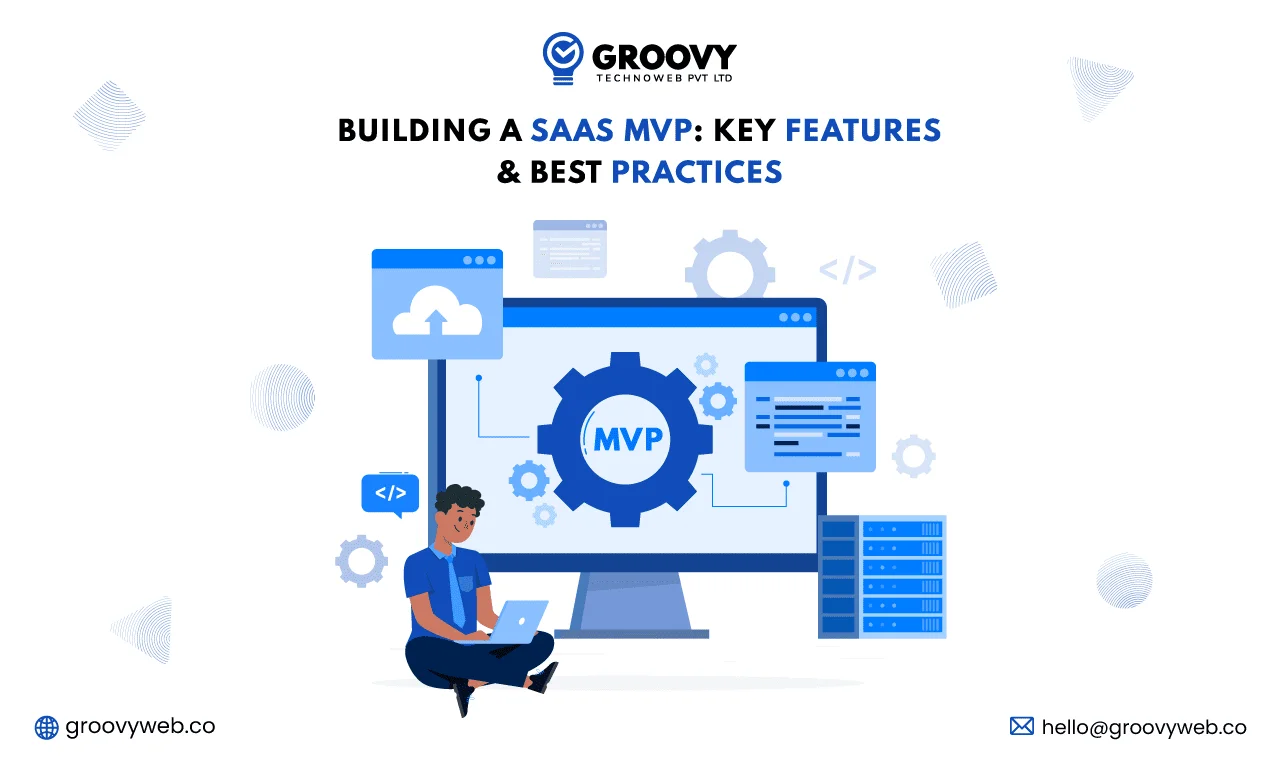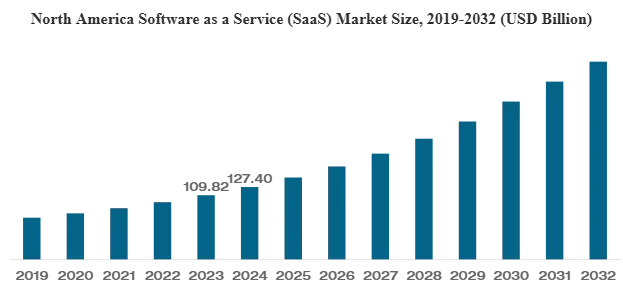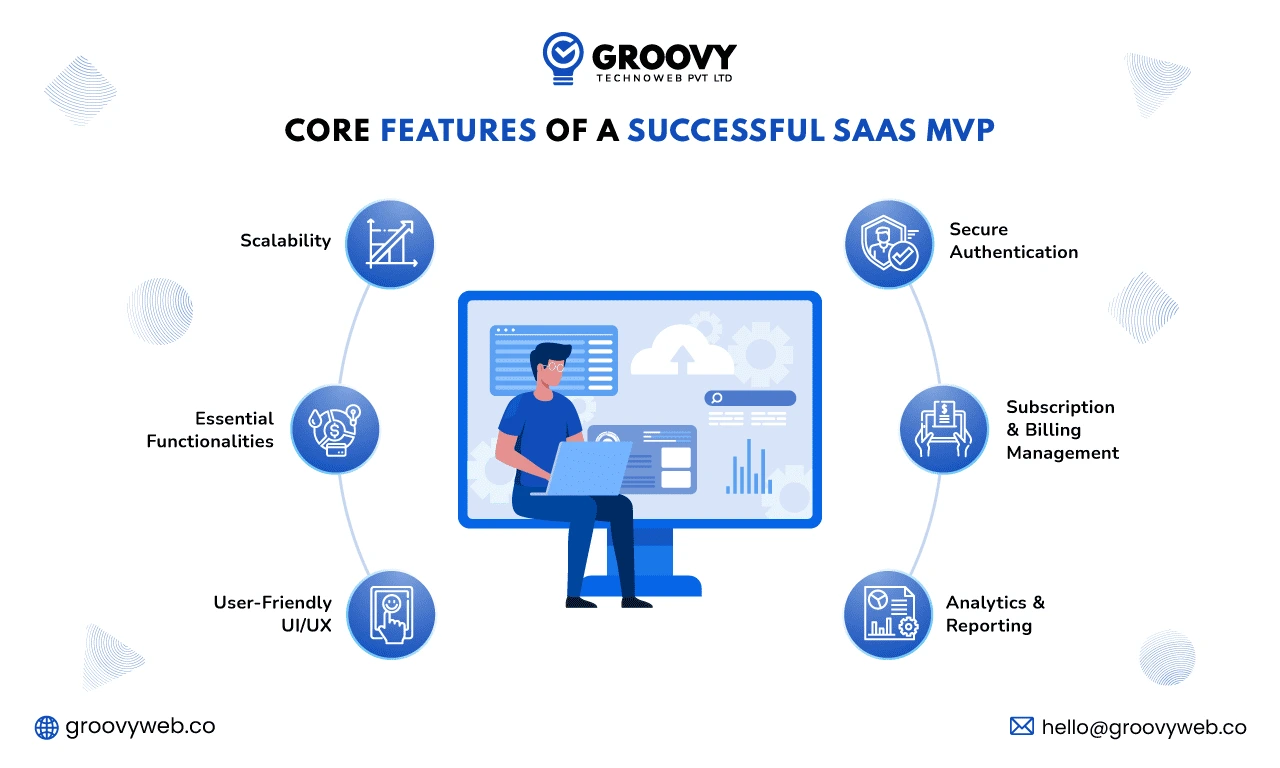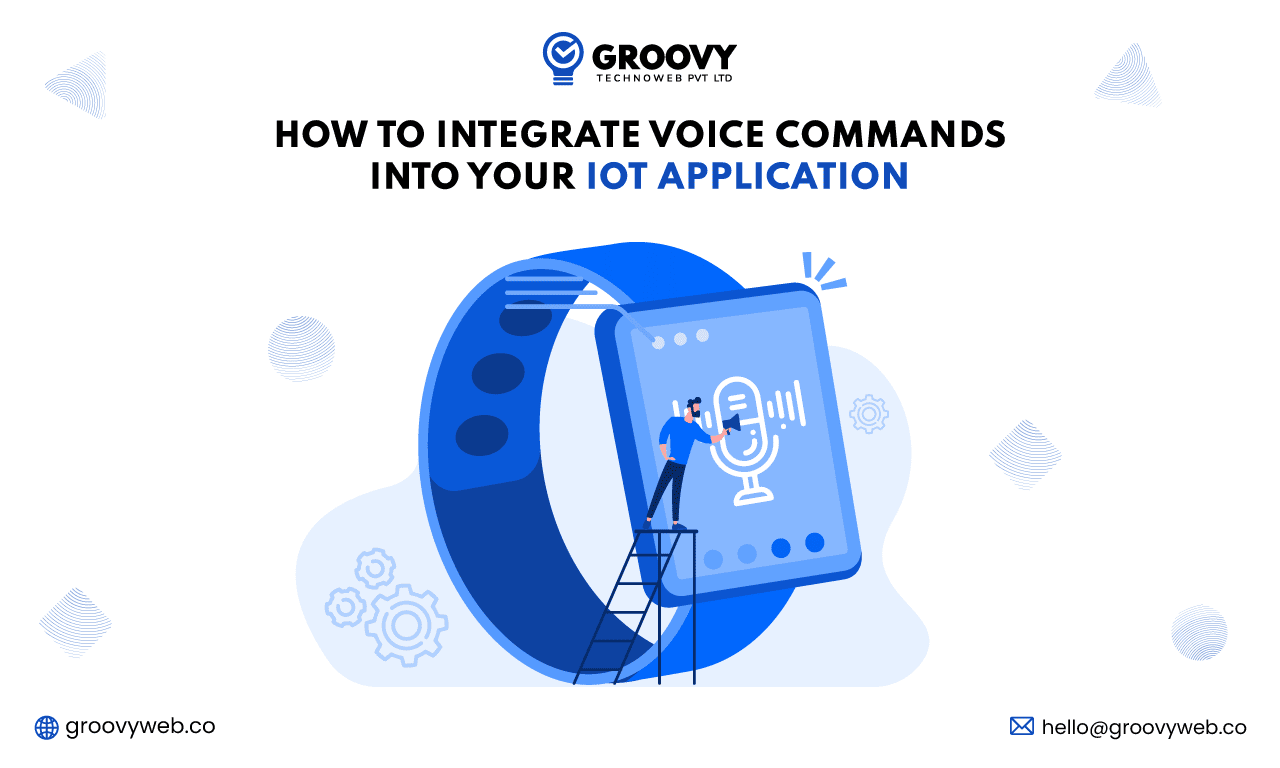Building a SaaS MVP: Key Features & Best Practices
Nauman Pathan
March 07, 2025 74 Views
Quick Summary : Building a SaaS MVP is a crucial step for startups and businesses looking to validate their ideas, reduce risks, and bring their product to market efficiently. By prioritizing core features, scalability, security, and user feedback, companies can build a strong foundation for long-term growth. Continuous improvements, data-driven decisions, and iterative scaling ensure that an MVP evolves into a full-scale, profitable SaaS solution.
The SaaS sector has expanded significantly, giving businesses affordable and scalable cloud-based services. According to research, the estimate of the worldwide Software as a Service (SaaS) market hitting $908.21 billion by 2030.

It is costly and risky to create a complete SaaS product without initially gauging market receptiveness. This is where Minimum Viable Product (MVP) development comes in.
SaaS MVP represents an initial product launch with the minimum number of required features to address a problem and obtain early buyers. It enables companies to confirm product-market fit, collect feedback, and make adjustments to development efforts prior to significant investment in bulk development. In this way, it minimizes risk, conserves funds, and moves time-to-market, with scope for ongoing expansion.
Ready to take your SaaS MVP to the next level? Explore our SaaS development services and see how Groovy Web can help you build a robust, high-performance SaaS solution that stands out in a competitive market!
What is a SaaS MVP?
A SaaS Minimum Viable Product (MVP) is a lean version of a SaaS product that contains bare minimum functionalities alone to test an idea in the market. The primary intention of an MVP is to pilot product feasibility with minimal resources while accumulating valuable user feedback for iterative improvement.
Unlike a full-grown product, an MVP enables businesses and startups to quickly launch, acquire early adopters, and iterate features from feedback in the real world. Airbnb, Dropbox, and Slack began as MVPs and later became successful in their space.
Why is Building an MVP for SaaS Important?

Creating an MVP prior to the release of a full-fledged SaaS product has many strategic advantages:
- Quicker Time to Market – Rather than spending months or years developing a full-fledged product, an MVP allows companies to bring it out speedily and collect early feedback.
- Cost-Effective Development – Focuses on the core functionalities, keeping additional expenses in check and maximizing the development effectiveness.
- Decision-Making from Data – In-time user statistics and feedback serve to refine the product and enable data-driven decision-making improvements.
- Early Funding & Monetization Opportunities – With an MVP, companies can monetize their service early and be able to appeal to potential investors by showing true-world demand.
Key Benefits of Launching an MVP Before a Full-Scale Product
- Less Business Risk – An MVP for SaaS makes it possible to test the product in a controlled environment, reducing the risk of market rejection.
- Market Demand Validation – Validates that customers truly want the product before spending a lot on development.
- Attracting Investors – An MVP that performs well with users is more likely to attract venture capitalists and angel investors.
- Better Product-Market Fit – Early adopters offer insights and shape the product in a manner that best fits market requirements.
- Competitive Advantage – A rapid go-to-market approach allows you to create brand visibility before competing solutions are out on the market.
Real-World Examples of Successful SaaS MVPs
- Dropbox began with an explainer video demonstrating its idea, getting thousands of signups before developing the product.
- Airbnb first came on the scene with a simple website, where homeowners could rent out their homes, proving demand before expanding.
- Slack originally came as an internal communication tool, then later perfected from feedback from its users to be a worldwide SaaS giant.
By adopting the SaaS MVP approach, businesses can develop scalable, customer-centric products that foster sustainable growth and long-term success. In the following section, we’ll explore the key characteristics of an effective SaaS MVP and how they contribute to business expansion.
Looking to build a powerful MVP that captures investor interest and attracts early adopters? Explore our MVP development services, featuring a comprehensive step-by-step guide on MVP development, essential strategies, cutting-edge tools, and frameworks to ensure a successful launch.
Core Features of a Successfully Building a SaaS MVP
Creating a SaaS MVP involves a thoughtful set of features that strike a balance between functionality, scalability, and user experience. An MVP well designed should concentrate on providing value to users and leaving space for future growth. The goal is to prove the business concept, identify early adopters, and create a platform for iterative improvement.
42% of startups fail because there is no market need for their product, as reported by CB Insights. This emphasizes the need to identify the correct features and make sure they meet user needs. The following are the most important features that every successful SaaS MVP must have:

1. Scalability – Building a Flexible Architecture for Future Growth
Scalability is important for a SaaS MVP since with more users, the system needs to be able to support more traffic without the performance being affected. Scalable MVP means that companies can grow their product without redesigning that are expensive.
Cloud Infrastructure: AWS, Google Cloud, and Microsoft Azure are a few of the providers that provide on-demand scalability, which provides smooth performance even with increased user usage.
- Microservices Architecture: Compared to monolithic applications, microservices enable scaling of different components independently, improving efficiency.
- Database Optimization: Use of NoSQL databases like MongoDB or scalable SQL solutions like PostgreSQL helps in efficient management of large datasets.
- API-First Approach: Designing APIs from the outset ensures that integrations and third-party services down the line can be added without any hassle.
2. Essential Functionalities – Must-Have vs. Nice-to-Have Features
Separating core features from secondary enhancements is important to avoid unnecessary complexity in the MVP stage.
Must-Have Features:
- User Authentication & Authorization (Login, role-based access)
- Core Service Offering (The core function that addresses the user’s pain point)
- Dashboard & Analytics (Simple monitoring of user behavior and interactions)
- Subscription & Billing Management (For monetization and plan customization)
Nice-to-Have Features:
- Advanced AI & Automation (To be used for predictive analytics or automation functionalities)
- Multi-Language & Localization (For global user adoption)
- Custom Integrations (Third-party software integration like CRM or ERP solutions)
3. User-Friendly UI/UX – Intuitive and Smooth Experience
The success of a SaaS MVP lies in the user experience. Streamlined UI/UX reduces churn and enhances user retention.
- Minimalistic Design: Simple and intuitive, nothing more. Unnecessary clutter will only lead to frustration.
- Mobile-Responsive UI: With mobile usage being at the forefront of SaaS interaction, responsive design is a necessity.
- Onboarding Experience: The initial experience matters; smooth onboarding experience boosts user adoption.
- Accessibility Compliance: Enable WCAG (Web Content Accessibility Guidelines) to make it accessible to all.
4. Secure Authentication – Login, Role-Based Access, and Data Protection
Security is taken very seriously in SaaS development because data breaches are costly and damaging. Having strong authentication processes protects user information and builds confidence.
- OAuth & Single Sign-On (SSO): Implementing authentication standards like OAuth 2.0, SAML, and OpenID Connect makes it more secure.
- Role-Based Access Control (RBAC): Ensures different users have appropriate permissions in the system.
- Encryption & Compliance: Encrypting sensitive data with AES-256 encryption and adherence to GDPR, HIPAA, and SOC 2 compliance.
5. Subscription & Billing Management – Payment Gateway Integration
Monetization is a key aspect of SaaS businesses, and hence subscription and billing management is a necessity in an MVP.
- Payment Gateways: Integrate stable gateways like Stripe, PayPal, or Braintree for secure transactions.
- Pricing Models: Implement variable pricing models like freemium, pay-per-use, and tiered subscriptions.
- Automated Billing: Have definitive billing cycles with automated bills and taxation.
- Free Trials & Discounts: Gain new users by trials or introductory discounts.
6. Analytics & Reporting – User Behavior Monitoring for Data-Driven Optimization
Data-driven decision-making is paramount in optimizing the SaaS MVP. Inching analytics into product enables understanding of user behavior, improved retention, and the ability to make necessary optimizations.
- User Engagement Metrics: Track daily active users (DAU), monthly active users (MAU), and churn rates.
- Funnel Analysis: Determine drop-off points in user flows to optimize onboarding and engagement.
- Heatmaps & Session Recordings: Use tools like Hotjar or Crazy Egg to observe how users are interacting with the platform.
- Performance Reports: Generate reports on uptime, response times, and infrastructure performance.
User Feedback Mechanism for Continuous Improvement
Having a successful SaaS MVP is not about product launch—it’s about getting better with time based on user needs. User feedback is the backbone of ongoing product development. Having systematic feedback channels in place guarantees that companies can polish features, make them more usable, and enhance customer satisfaction.
Feedback Loops and Surveys Implementation
- In-App Surveys: SurveysMonkey, Typeform, and Google Forms enable direct collection of user feedback within the application.
- Net Promoter Score (NPS): Reports customer satisfaction and discovers promoters, passives, and detractors.
- Customer Support Tickets & Chatbots: Applications such as Zendesk and Intercom support real-time user feedback and issue tracking.
Feature Validation using A/B Testing
- Testing of UI Changes: A/B testing software such as Optimizely and Google Optimize assist in determining the performance of design updates.
- Feature Rollouts: Roll out features to a group of users prior to complete deployment to test acceptance.
Iterating on Customer Insights
- Prioritizing Feature Requests: Prioritize features based on customer data on what to build next.
- Product Roadmap Adjustments: Bring product development in line with actual user needs for long-term success.
By proactively incorporating user feedback, SaaS companies can create a product that’s in sync with customer expectations and achieves long-term engagement.
Technical Considerations for Building a SaaS MVP Development
Selecting the proper technical foundation is key to the long-term success of a SaaS MVP. An inferior technical setup can result in performance problems, security risks, and scalability issues. By choosing the right tech stack, deployment model, and security practices, companies can build a solid and efficient product.
Choosing the Appropriate Tech Stack
The technology stack determines the performance, maintainability, and scalability of a SaaS MVP. The optimal stack should fulfill business requirements, development velocity, and scalability requirements.
- Frontend: React.js, Vue.js, or Angular for interactive and dynamic user interfaces.
- Backend: Node.js, Ruby on Rails, or Django for efficient server-side processing.
- Database: PostgreSQL, MySQL, or MongoDB for structured and flexible data storage.
- Hosting & Cloud Services: AWS, Google Cloud, or Microsoft Azure for secure and scalable infrastructure.
The right stack chosen aids faster development cycles, enhanced integration capability, and scalability over the long term.
Cloud-Based vs. On-Premises Solutions
When developing an MVP for SaaS, businesses are forced to choose between a cloud-based or on-premises model of deployment. They have their advantages.
Cloud-Based Solutions:
- Scalability: Scale up or down easily as required.
- Lower Maintenance: Leave updates, security, and server management to the cloud provider.
- Faster Deployment: Avoid in-house infrastructure, minimizing time-to-market.
On-Premises Solutions:
- Higher Control: Data storage and security measures are controlled by companies.
- Compliance Requirements: Needed for data-hungry sectors with rigid data policies such as healthcare and finance.
- More Upfront Costs: Needs exclusive infrastructure and periodic upkeep.
Most SaaS MVPs go with cloud solutions, which are cheaper and offer high flexibility.
Data Security and Compliance
Security is of utmost importance in SaaS development, since a single breach of data could prove to be expensive and harm user trust. With tight security measures in place from the start, sensitive data is protected, and industry standard compliance is assured.
- End-to-End Encryption: Encrypt data for secure storage and transmission using AES-256 encryption.
- Role-Based Access Control (RBAC): Restrict access based on user roles to add an extra layer of protection.
- Regulatory Compliance: Ensure GDPR, HIPAA, SOC 2, and ISO 27001 compliance.
- Regular Security Audits: Conduct penetration testing and vulnerability scanning to identify and close security vulnerabilities.
Putting the secure and scalable technical backbone at the forefront, SaaS firms can build an MVP that not only runs but is future-proof and adheres to industry best practices.
Best Practices for a Smooth SaaS MVP Launch
An expertly executed launch can make or break a SaaS MVP. Even the greatest product concepts may fail if not tested, promoted, and benchmarked for performance. Launching according to best practices guarantees smooth sailing, accumulating early adopters while reducing probable pitfalls.
Beta Testing Prior to Public Release
Releasing a beta version allows startups to identify bugs, increase testing, and take early user feedback before rolling it out large scale. Beta testing validates technical functionality and user interface, delivering a smoother public debut.
Advantages of Beta Testing:
- Catch and resolve issues early – Prevent catastrophic errors that harm the brand.
- Validate user experience (UX) – Collect feedback to maximize usability and workflows.
- Make sure it scales – Test infrastructure performance at varying user loads.
- Create early champions – Turn beta testers into brand champions.
How to Conduct Successful Beta Testing:
- Select a Target Audience: Invite a diverse group of early adopters who are the product’s most likely users.
- Establish Test Objectives: Prioritize usability, performance, and feature verification.
- Use Beta Testing Platforms: Apply tools like TestFlight (for iOS applications), Google Play Beta, or BetaTesting.com.
- Gather User Feedback: Conduct surveys, in-app feedback forms, and interviews.
- Iterate on Data: Improve the product from the results of beta testing before release.
Marketing Strategies for SaaS MVPs
An MVP without users is merely an incomplete product. A robust marketing plan ensures your SaaS MVP finds the right people and creates traction on day one.
Best Marketing Strategies for a SaaS MVP:
Use Content Marketing:
- Write knowledgeable blogs, case studies, and whitepapers based on the SaaS domain.
- Optimize SEO with high-traffic keywords such as SaaS MVP development, early-stage SaaS growth, etc.
- Guest blogging on platforms that are related to your niche such as Medium, Forbes, and TechCrunch.
- Construct LinkedIn, Twitter, and Reddit forums around your MVP.
- Post product development progress on Product Hunt, Indie Hackers, and SaaS communities.
- Reach out to industry influencers for potential collaborations and endorsements.
Referral & Early Access Programs:
- Provide incentives like discounts, premium features for free, or priority access to incentive referrals.
- Utilize referral tools such as ReferralCandy or Viral Loops to make it automated.
Paid Advertising & PPC Campaigns:
- Create Google Ads and LinkedIn Ads based on specific business requirements.
- Try A/B testing to improve the performance of ads.
Email Outreach & Cold Emails:
- Personalize emails with concise value propositions and customer pain points.
- Employ automation software such as Mailchimp, HubSpot, or Lemlist for cold outreach.
Measuring Success Metrics and KPIs
Knowing if your MVP is catching on involves measuring the appropriate Key Performance Indicators (KPIs). They serve to establish areas of enhancement and confirm business viability.
- Critical KPIs for a SaaS MVP:
User Acquisition & Activation:
- Sign-Up Conversion Rate: The proportion of visitors signing up.
- User Activation Rate: The number of users who get through the onboarding process.
User Engagement & Retention:
- Daily Active Users (DAU) & Monthly Active Users (MAU): Measures product usage.
- Churn Rate: The proportion of users who abandon the product.
- Feature Adoption Rate: Identifies the most useful features.
Revenue & Monetization:
- Customer Acquisition Cost (CAC): Sees how much it costs to obtain a customer.
- Customer Lifetime Value (CLV): Estimates the overall revenue per customer.
- Monthly Recurring Revenue (MRR): Estimates recurring subscription revenue.
User Feedback & Customer Satisfaction:
- Net Promoter Score (NPS): Measures how satisfied users are and how likely they are to refer.
- Customer Support Tickets & Resolution Time: Indicates product reliability and user-friendliness
How to Track MVP Performance?
- Use Google Analytics, Amplitude, or Mixpanel for user behavior analysis.
- Monitor in-app activity and conversions through Hotjar or Crazy Egg.
- Automated reporting of KPI through Tableau or Looker.
Summary of Key Takeaways
Creating a SaaS MVP is a strategic strategy that enables companies to test their concepts, gain early adopters, and refine product development prior to large-scale production. By following the best practices outlined, businesses can mitigate risks, save costs, and shorten time-to-market, laying a solid foundation for long-term growth.
Here are the main takeaways:
- Begin with the Necessities: Prioritize essential features that offer genuine user value and steer clear of unwanted complexity.
- Scalability is Important: Design an architecture that can support growth in the future, leveraging cloud services such as AWS, Google Cloud, or Microsoft Azure.
- Feedback from Users is Important: Adopt feedback loops, perform A/B testing, and polish features using actual user input.
- Security & Compliance First: Protect data, role-based access control (RBAC), and GDPR, HIPAA, or SOC 2 compliance.
- Strong Marketing Strategies: Leverage content marketing, social media, paid advertising, and referral programs to acquire and retain users.
- Track Success with KPIs: Monitor user acquisition, engagement, revenue metrics, and churn rates to improve product performance.
At Groovy, they specialize in custom SaaS solutions that align with industry best practices, ensuring that your MVP evolves into a fully scalable and profitable product. Our team provides end-to-end SaaS development, helping you refine features, optimize infrastructure, and scale with confidence. Get your SaaS MVP to market faster with our expert MVP development services.
Next Steps After building a SaaS MVP
Releasing an MVP is only the first step. The real measure of a SaaS product’s success comes from how well it continues to grow and adapt in line with user requirements and market needs. Here’s what to do next:
- Measure MVP Performance: Employ analytics packages such as Google Analytics, Mixpanel, or Amplitude to monitor user activity and feature adoption.
- Improve User Experience: Upon feedback, develop UI/UX, enhance onboarding sequences, and streamline customer support paths.
- Prioritize Feature Growth: Recognize in-demand features from customer requests and provide updates in incremental cycles.
- Optimize & Scale Pricing Models: Experiment with multiple subscription tiers, discounts, and freemium models to gain maximum revenue.
- Invest in Growth Marketing: Diversify acquisition channels with SEO, influencer marketing, performance ads, and collaborations.
- Ensure Ongoing Security & Compliance: Periodically update security controls, perform penetration testing, and remain compliant with industry standards.
Final Thoughts
A successfully executed SaaS MVP not only proves the product concept, but it also establishes the long-term scalability and profitability foundation. By executing the strategies presented in this guide, companies can secure a successful launch of their SaaS MVP as well as durable growth.
The path doesn’t conclude at MVP—it’s all about ongoing innovation and improvement. Prepared to take your SaaS MVP to a fully-fledged platform? Apply these best practices, tap into user feedback, and see your product flourish in the competitive SaaS market!
Written by: Nauman Pathan
Nauman Pathan is a Project Manager at Groovy Web - a top mobile & web app development company. He is actively growing, learning new things, and adapting to new roles and responsibilities at every step. Aside from being a web app developer, he is highly admired for his project management skills by his clients.
Frequently Asked Questions
We hope these clear your doubts, but if you still have any questions, then feel free to write us on hello@groovyweb.coHow long does it take to develop a SaaS MVP?
The timeline for SaaS MVP development varies depending on the complexity of the features and the team’s expertise. A well-planned MVP ensures faster time-to-market while allowing room for improvements based on user feedback.
What are the key features of a successful SaaS MVP?
A successful SaaS MVP includes scalability, user-friendly UI/UX, secure authentication, subscription management, analytics, and a feedback mechanism to refine the product. For a detailed breakdown of essential SaaS features, check out our SaaS Application Development Guide.
How do I choose the right tech stack for my SaaS MVP?
The right tech stack depends on your product’s needs. Popular options include React.js, Vue.js for frontend; Node.js, Django for backend; and AWS, Google Cloud for hosting. Consulting with an experienced SaaS development team can help determine the ideal technology.
How much does it cost to develop a SaaS MVP?
The cost of SaaS MVP development depends on factors such as feature complexity, security measures, and scalability needs. The investment should be planned strategically to balance development efficiency and market readiness.
Related Blog

Krunal Panchal
Groovy Web Recognized As Industry Leader In India By Team App Development
Achivements 09 Jan 2025 3 min read
Rahul Motwani
How to Integrate Voice Commands into Your IoT Application
Mobile App Development 18 Dec 2024 6 min read
Rahul Motwani
How is AI Chatbot Useful for the E-commerce Industry?
Chatbot Development 13 Mar 2025 10 min readSign up for the free Newsletter
For exclusive strategies not found on the blog